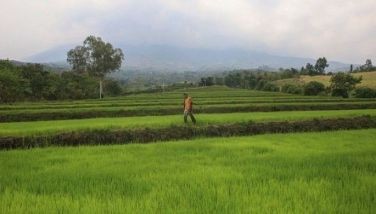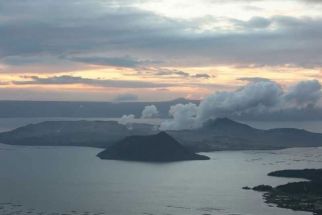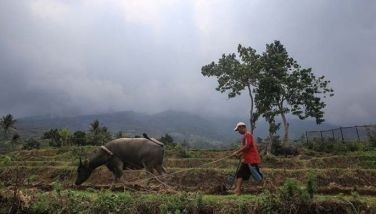Fighting windmills in Masungi
“Ondoy started here.” If that memory of the catastrophic flood that turned much of Metro Manila into a deadly swamp in 2009 doesn’t chill you, then little else will.
The man telling me this as he sweeps his hand over the vast Upper Marikina Watershed below and around us is Ben Dumaliang. At 68, Ben is exceptionally articulate for a civil engineer, but he needs to be, because he’s no longer just building houses. For almost 30 years, he’s been building the Masungi Georeserve – a 3,000-hectare expanse of mostly forest land on the slopes of the Sierra Madre along the boundary of Tanay and Baras, Rizal.
Masungi sits on the watershed that both nourishes and protects Metro Manila, providing it with fresh water while helping to keep flooding in check – if things like trees and streams are where and how they’re supposed to be. And there’s the problem that helped a freak downpour like Ondoy become the biblical torrent it turned out to be.
“Much of this was logged over not too long ago,” says Ben. “We had to reclaim the land from the loggers, the quarry companies and the land speculators, and then reforest it.”
Today the Masungi Georeserve is about as close to a natural Eden as you can get this close to the city – about 30 kilometers from where I live in Diliman – with lush new growths of Philippine trees, unique plants and animals such as the purple jade vine and the Masungi microsnail, and hundreds of endemic species including 72 kinds of birds.
But it wasn’t always that way, as Ben recalls the georeserve’s unlikely beginning. “This was government land that the Department of Environment and Natural Resources (DENR) intended to use for employee housing back in the 1990s. In 1996, my construction company, Blue Star, won the bidding for the housing project, and we began building roads on the property and making improvements on it. However, the land had been chopped up among various syndicates, and the DENR failed to deliver on its obligation to clear the land of settlers, and after a while people lost interest in living here and the housing project stalled.”
In the meanwhile, Ben had begun to appreciate the natural beauty of the place, despite its ravaged state, and started developing parts of it – particularly the centrally located Lot 10, which remains the hub of the georeserve. He began taking the land back from its illegal settlers, who included rich and powerful people who had put up cottages in the area.
Almost immediately, he began to get blowback. “Our rangers were shot at and mauled when they tried to do their job, and the police did nothing about it.”
Not surprisingly, Ben says that a group of police generals had apportioned parts of the watershed among themselves, citing the Marcos-issued PD 324 which had declared these lands alienable (conveniently forgetting that PD 324 was effectively repealed by Marcos himself under the Forestry Code, aka PD 705, and by Presidential Proclamation 1636 prohibiting tree cutting and dwelling in the watershed).
In 2015, Ben’s daughters Billie and Ann set up the Masungi Georeserve Foundation, to which Blue Star entrusted the care and management of the area. (Ben is a principal in both entities, and both daughters remain active in the foundation.)
It was in 2017 that the most auspicious turn happened for Masungi. Then newly appointed DENR Secretary Gina Lopez visited the place, liked what she saw – particularly what Ben and his people were doing to restore and conserve the forest – and had a contract drawn up between the DENR and the foundation, granting it the right and obligation to replant the georeserve.
Today sturdy growths of Benguet pine crown the hilltops of the watershed. The georeserve is thick and picturesque with trees, orchids and returning wildlife. A limited number of ecotourists come every day to hike trails that weave through the sharp karst limestone landscape.
But not far below the pine trees, Sitio San Roque in Baras remains host to a bustling community (that reportedly includes, yes, at least one police general and one high-ranking government official who owns a pool resort, against whom a case had been filed but who was allowed to retire with full benefits). “The syndicates and rogue officials are the root cause of deforestation and environmental degradation,” says Ben. “I fear for my life and my family’s,” he admits. “It’s very easy to die in a place like this.” (For more background information, refer to my fellow columnist Jarius Bondoc’s piece from Sept. 13, 2023, titled “DENR ignoring public appeals to evict watershed landgrabbers.”)
The threats are more than personal. Insanely, the Bureau of Corrections managed to secure 270 hectares in the heart of the reserve to build a new national penitentiary and its headquarters there. The DENR also reportedly agreed for Tanay to build wind turbines on the ridge overlooking Lot 10. Neither project can possibly be good for jade vines, microsnails – and people, for that matter.
Some days, Ben feels like he’s fighting windmills in Masungi – and not just the literal ones, either. He doesn’t understand what he sees as the antipathy of the DENR toward him and the foundation. The DENR wants his contract canceled, ostensibly because he had gotten Sec. Lopez to sign it when she was ill and just before she left office after failing to be confirmed (Ben denies this, saying she was the one who insisted on the contract getting done. “They seem to think I’m getting rich from this, but in fact I’ve been drawing from my own resources for the georeserve,” he explains. The MGF gets no funding from the government and relies on its limited income and on private support for its operations.) DENR Sec. Ma. Antonia Yulo-Loyzaga, he says, has ignored all his letters and requests to meet to thresh out any issues between them.
Nature reserves don’t grow just trees – they breed enemies, few of them natural; most walk on two feet.
(On a rather distressing side note, I have good and trustworthy friends on both sides of this issue messaging me to believe this and not to believe that. For the moment, I’ll have to believe the evidence of my eyes, but to be fair, I invite the DENR to send me their comments, and specifically their answer to this simple question: “What is the Masungi Georeserve Foundation doing wrong?”)
* * *
Email me at [email protected] and visit my blog at www.penmanila.ph.
- Latest
- Trending




























